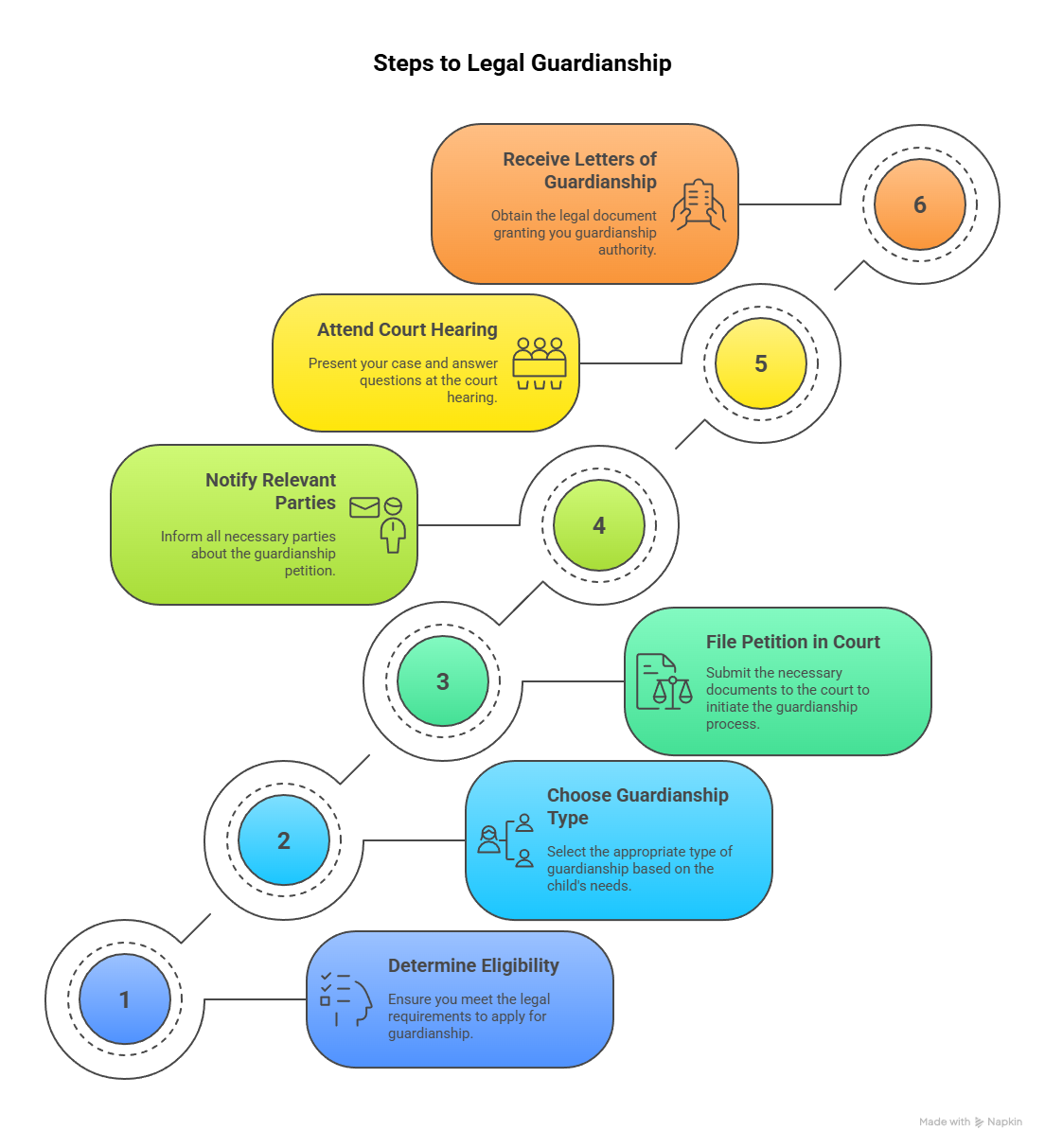Legal guardianship allows a person who is not the child’s biological parent to care for and make important decisions for a child. This can include providing housing, enrolling the child in school, obtaining medical care, and managing finances on the child’s behalf. Unlike adoption, guardianship does not permanently sever the legal rights of the child’s birth parents. Instead, it gives the guardian temporary or long-term authority while preserving parental rights, unless otherwise ordered by the court.
Guardianship is often used when parents are unable to care for their child due to illness, incarceration, substance abuse, military deployment, or other serious personal circumstances. It can provide stability and legal clarity for the child without requiring a complete termination of parental rights. The process is court-supervised, ensuring that the arrangement is in the best interest of the child.
Whether you are a relative (like a grandparent, aunt, uncle) or a family friend seeking guardianship, this guide will walk you through the entire process. It includes eligibility criteria, legal procedures, responsibilities of a guardian, and how to end or modify the guardianship later, if needed.
Table of Contents
Understanding the Difference Between Guardianship and Adoption
| Guardianship | Adoption |
|---|---|
| Temporary or long-term | Permanent and lifelong |
| Biological parents still have rights | Parental rights are permanently terminated |
| Can be reversed or modified | Usually irreversible |
| Court oversight continues | No ongoing court oversight after finalization |
| Child may inherit from biological parents | Inherits only from adoptive parents |
Step-by-Step Process to Obtain Legal Guardianship (Without Adoption)

Step 1: Determine Eligibility
To file for legal guardianship, you must:
- Be at least 18 years old
- Be physically and mentally capable of caring for the child
- Not have any serious criminal convictions (background checks are required)
- Be a U.S. resident or legally present in the country
Relatives, close family friends, or other trusted adults may all be eligible, depending on the state’s laws.
Step 2: Choose the Type of Guardianship
There are typically three main types of guardianship:
- Guardianship of the Person: Covers daily care, school, and health decisions.
- Guardianship of the Estate: Applies when a child has money or property needing management.
- Temporary or Emergency Guardianship: Granted for a limited period, often in crisis situations.
In most cases, guardianship of the person is the type you will apply for.
Step 3: File a Petition in Court
You must file a Petition for Appointment of Guardian of a Minor with your local Family or Probate Court. The exact form names vary by state, but commonly required documents include:
- Petition for guardianship
- Consent of parents (if possible)
- Child’s birth certificate
- Proof of relationship (if applicable)
- Declaration explaining why guardianship is necessary
- Criminal background check and fingerprint clearance (in many states)
Some courts may require you to attend a guardianship orientation or watch an instructional video before filing.
Step 4: Notify Relevant Parties
Once your petition is filed, you are legally required to notify:
- The child’s biological parents
- Other relatives (sometimes required)
- The child, if they are age 12 or older (in many states)
- The child’s tribal affiliation, if they are Native American (ICWA compliance)
This is done through official service of process, often by mail, sheriff, or a professional process server.
Step 5: Attend the Court Hearing
The court will schedule a guardianship hearing. You must be prepared to:
- Explain why guardianship is necessary
- Show evidence that it is in the best interest of the child
- Answer the judge’s questions regarding your relationship with the child, housing, income, and ability to care for them
- Present proof of parental consent or, if consent is not provided, explain why it is not required (e.g., abandonment, neglect, or incarceration)
If there is no opposition and the judge is satisfied, the court will approve the guardianship.
Step 6: Receive Letters of Guardianship
Once approved, the court will issue Letters of Guardianship, a legal document that gives you the authority to act on the child’s behalf. You will use these to:
- Enroll the child in school
- Obtain health care
- Apply for government benefits (e.g., Medicaid, SSI if eligible)
These letters are often valid for a specific term and must be renewed or reviewed periodically.
Additional Responsibilities and Oversight
Guardians may be required to:
- File annual status reports with the court
- Keep records of the child’s medical and educational progress
- Inform the court of any major changes (e.g., change of address or school)
Some states assign a court investigator or social worker to periodically check on the child’s well-being.
How to End or Modify a Guardianship
Guardianship can end:
- Automatically when the child turns 18
- By court order if the parent regains the ability to care for the child
- If the guardian resigns and a replacement is approved
- Upon death of the guardian (a standby guardian may be appointed)
Either the parent or guardian may petition the court to modify or terminate the guardianship.
When Parental Consent Is Not Required
Parental consent may be waived by the court if:
- The parents have abandoned the child
- The parents are incarcerated or incapacitated
- The parents are found unfit due to abuse or neglect
In such cases, the court may appoint a guardian over the parents’ objections, but this requires substantial evidence and legal representation may be recommended.
Legal guardianship offers a stable solution for children who cannot be cared for by their parents but do not need to be permanently adopted. The process involves detailed court procedures to ensure the child’s best interests are protected. While it does not sever parental rights, it provides the guardian with the authority and responsibility to care for the child’s well-being.
If you’re considering guardianship, it’s advisable to consult a family law attorney or reach out to your local family or probate court for guidance on forms and procedures specific to your state. Many courts also provide self-help services and guardianship clinics for non-lawyers.



